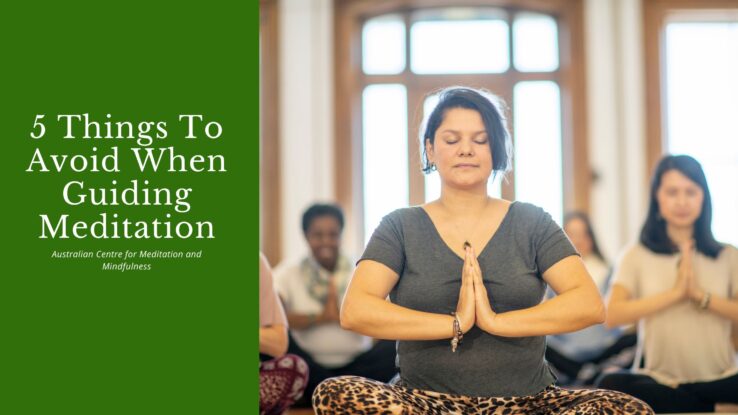5 Things To Avoid When Guiding Meditation
Guiding meditation is one of the ways that mindfulness and meditation teachers can share their skills and knowledge with others. Guiding meditation can support attendees to witness and enter their own inner landscape, enabling them to explore their mind, body, and heart in a profound way.
To facilitate this journey for attendees effectively, there are certain things to keep in mind. This way we can guide meditation in a way that supports them feeling prepared both externally and internally, and safe in allowing this process to unfold naturally, and in a way that resonates for them.
Each meditation teacher will have their own style of teaching which provides a tapestry of meditation experiences, however there are a few things that it is best to avoid when guiding meditation, whatever technique is chosen.
1. Rushing the guidance
Potentially one of the more challenging aspects of guiding meditation is learning how to slow down the pace of your voice. The pace of your voice can be an essential part of providing a gentle and relaxing experience for attendees and it’s normal for this to feel a little tricky when starting out in guiding meditation. A slower pace of voice will allow you to deliver your meditation with clarity, ensuring attendees can follow your guidance.
There are a few ways you can support yourself with this:
- If you can, it’s a great idea to allow plenty of time before the beginning of your class to arrive at the venue or log-into the online meeting room. This will ensure you don’t feel rushed or stressed before you begin your class. You’ll be amazed how much these feelings can impact the pace of your guidance and you may talk faster than normal without even realising it.
- You may also like to allow time to meditate or connect gently with your own breath before you begin. This will help slow down your breathing (if needed) which will naturally flow over into the pace of your guidance. This is also a great time to check in with any feelings of nervousness or restlessness you may be feeling and take a few moments to honour these and engage in other supportive practices such as some gentle movement to help release this excess energy or affirmations such as “I am calm”, “I am capable”, “I am at ease”.
- Once you begin the meditation, connect back to your own breath throughout the practice. A great tip for slowing down the pace of your voice during you meditation is to take two to three slow, quiet breaths after each moment of guidance to ensure your pace remains gentle and steady. For example, you may guide attendees to connect to their sense of hearing and then take two to three breaths before continuing to guide them to connect to their sense of touch.
2. Using directive language
Language is powerful and can evoke many feelings and emotions which is why it’s important to ensure that the language used when guiding meditation is gentle and  supportive. One of the key ways to ensure a soft approach is to use invitational language rather than directive language.
supportive. One of the key ways to ensure a soft approach is to use invitational language rather than directive language.
Invitational language allows attendees to connect to the practice in their own way and opens up options that works for them. Giving people options allows the attendee to feel empowered, and to choose the option that works best for them based on their current needs.
Phrases such as “you may like to”, “if it feels right for you”, “when you’re ready” are examples of invitational language.
On the other hand, directive language is more certain and precludes choice. While it may be beneficial in circumstances such a yoga class where definitive guidance is appropriate, during guided meditation the intention is to always allow the attendee to have free choice over their experience.
3. Over-complicated guidance
As the saying goes, “silence is golden”. It can be tempting to want to fit all your wonderful ideas into one meditation, especially when there’s so much you want to share with the world. However, it’s important to allow plenty of time for silence to support attendees to connect with their experience, and time for them to be able to follow your guidance without feeling rushed or overwhelmed. One of the ways that you can support the feeling of spaciousness in your meditation is to allow plenty of time for silence throughout the meditation.
As we’ve already explored, a slower pace in your voice is a great way to create space in your meditation. Another great way is to use language that is concise and not too complex. You may like to consider reducing repetitive phrase such as “just”, “now” as well as considering instructions that can be condensed “Bringing your awareness to your sense of touch and start to notice”, could simply become “Starting to notice your sense of touch”. While both options work well and can be supportive, using less words and phrases can allow more space for silence and gentle pauses throughout your meditation if you feel this is needed.
Guidance that is simple, clear and concise allows the attendee to sink into their own depth of experience.
 4. Distractions
4. Distractions
As a meditation teacher there are logistical elements you may need to keep in mind while guiding a class. Perhaps there is a need to keep check of the time or have some workshops notes with you. While these things can’t be avoided, in order to facilitate a sense of connection to your guidance as well as attendees it’s best that distractions are kept to a minimum.
Some of the things you may like to consider to limit distractions could be:
- Wearing a watch or having a discreet clock displayed in the room to help you keep track of time without the need for other items such as phones which may become a distraction.
- If you can, consider the possible distraction of outside noises. While it’s impossible to limit all noises in a modern day world, closing doors, ensuring you have a relatively quiet place to teach, popping pets outside if you’re at home and turning off electrical items, such as televisions, in other rooms that are close by can be helpful. If guiding online, making sure computer notifications (such as new email notifications) are turned off can also help.
- Guiding with your eyes closed is a wonderful way to support a sense of connection with the practice. While it may be necessary to check on attendees from time to time, once this has been done closing your eyes once again will allow you to come back to the practice and share in the collective energy.
5. Using inappropriate music
Sound can be a beautiful addition to guided meditation and can support attendees to cultivate feelings such as relaxation and stillness, however sound can also spark other feelings such as overwhelm and agitation if an inappropriate track is chosen. There are many techniques where the interplay of music at different paces, tones and vibrations is called for, (such as dancing or listening meditations), the tips given below are for meditations where the guidance of the teacher is necessary, such as relaxation meditations.
When choosing music for meditation it’s best if you can:
- Choose music that is soft, gentle and doesn’t have too many overbearing instruments in the background. This will ensure that attendees are still able to follow your guidance. A great way to explore the suitability of music is to simply meditate to it yourself and consider, how does it make you feel? Was it distracting or a lovely addition to your practice?
- Use music that is instrumental only. Lyrics may provide a distraction during the meditation and interfere with your guidance.
- Keep music at a volume that can be heard but that doesn’t take over your guidance. If music is too loud it may be a distraction.
Of course, while all these tips are helpful to remember the most important thing to keep in mind is that as a teacher when you guide from: an inner place of connection, intuition and from the depth of your own personal meditation practice, these qualities will naturally flow into your teaching. As you explore your own experiences as a teacher you will sense what does and doesn’t feel right for you and your attendees. Honouring your own inner wisdom and listening to that is always going to be the best approach.
Happy teaching!
At ACMM we offer Certificate, Advanced Certificate and Diploma Training Options, with optional Business Development Support alongside and after your training. PLUS we now offer a Community Work Placement program as part of the Diploma course, where students will be given opportunities to teach meditation within support service organisations such as Aged Care, Hospitals and other Not for Profits and receive all they need to teach a 6 week course. Click here to learn more.
Find out if our courses are the right fit for you. Book a Zoom Discovery Call with Lisa Forde, ACMM Founder today!
Blog by ACMM Coach Sammy Wynn




